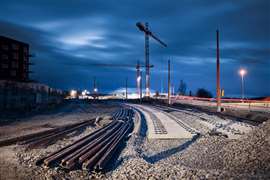Why tech upgrades needn’t be complicated
31 October 2023
For construction companies worldwide looking to maintain their footing in a tough market, there’s growing pressure to revisit and upgrade their tech stack.
 Construction-focused software is now an invaluable tool for both large and small businesses. Image: Unsplash
Construction-focused software is now an invaluable tool for both large and small businesses. Image: Unsplash
Increasingly, digital technologies are becoming an attractive option, and for good reason, as they can streamline processes, increase productivity and keep businesses industry-compliant.
Yet, searching for the right system can be overwhelming. A quick Google search will reveal endless articles on ‘how to achieve a digital overhaul’. While this might be the end goal, the process starts with small incremental improvements - and the solution is easier than you might think.
Often, what businesses want isn’t a reinvention of the wheel, they need technology designed to fit into existing workflows to support day-to-day tasks. With the right platform or software, this can be a relatively straightforward process, blending in seamlessly with teams, rather than forcing them to uproot established processes.
Ensuring a sound investment
A common issue is that business leaders have had their fingers burnt in the past by technology that missed the mark.
Changing entire tech stacks used to be an expensive process and came with a significant financial risk.
Furthermore, companies became entirely dependent on one software provider, and bringing about a tech change required a complete system overhaul that took months to put in place and upskill teams.
Thankfully, the industry has come a long way since then, and the fervent pace of technology means that massive cash injections and a sole reliance on one particular company are no longer necessary. In fact, in today’s world of information sharing and collaboration, the opposite is true.
Finding tech that speaks the same language
One of the most sought-after functions of modern day ‘ConTech’ is interoperability - the ability to integrate with and work alongside other programs and software.
Companies want to ensure their software stacks can communicate effectively and that vital information isn’t lost in translation. By doing so, they can streamline business functions, increase efficiency and, importantly, save time.
Choosing tech that operates in this way is now essential to embed seamless communication across projects and teams.
 Digital technology has the capacity to keep complex construction projects on track. Photo: Adobe Stock
Digital technology has the capacity to keep complex construction projects on track. Photo: Adobe Stock
Reports can be generated in seconds, documents logged and shared instantly, and communication channels between staff, C-suite and shareholders are greatly improved. It also means that new tech doesn’t become part of siloed channels; different business teams can operate as one.
What’s more, assimilated tech removes the headache of data-transferal, an often-complex process that can deter business leaders from making the leap in the first place.
The beauty is that now, integrating new platforms into a wider ‘tech’ ecosystem is easier than ever.
The power of data
One of the biggest draws to tech upgrades is to deliver a more ‘joined up’ approach to data collection. It’s been said that ‘data is the oil of the 21st century’, delivering new levels of business intelligence.
By analysing data, businesses can see which areas need improvements and those excelling.
Advanced analytics and real-time data collection offer a means to optimise workflows, predict project trends, equipment maintenance needs and ensure resource allocation aligns with project timelines.
And with tools like building information modelling, design plans are blended with on-the-ground data to create digital twins that can be moulded and simulated to predict design and build flaws.
But to obtain this level of data accuracy, tech needs to be easy-to-use and understood by all project stakeholders.
Adding a personal touch
There are tell-tale signs of a good piece of technology - mainly that it requires minimal training. It should be designed so that teams can simply ‘pick up and go’, and in the world of construction, where appetite for technology adoption is still growing, this point is worth its weight in gold.
Intuitive design is key. New platforms and equipment should be easy to get grips with so that users can get the most from it as early as possible.
This should be backed up by full support from the chosen tech supplier. Ongoing training sessions, tutorials, documentation, and responsive customer support should be expected as standard.
It’s worth noting that this should be ongoing to ensure maximum value. Constant contact also gives businesses a window to either scale up or scale down their tech should their needs change, something hugely relevant on larger projects with multiple phases.
 Rob Norton of PlanRadar. Photo: PlanRadar
Rob Norton of PlanRadar. Photo: PlanRadar
This is particularly helpful in situations where an organisation has different branches with unique needs.
Through an ongoing dialogue, tech providers can deliver a ‘holistic’ offering so that teams operate from the same platforms. Plus, construction tech teams can save time by avoiding additional rounds of research looking for new tech.
One click at a time
While the choice of digital platforms available to construction teams can at times be difficult to navigate, the benefits should not dissuade businesses from dipping their toes.
‘Levelling up’ has never been simpler, and it can start with piecemeal stages. The key is to find technology that resonates with a company’s unique needs, ensuring seamless integration and fostering collaboration.
In an era where technology is reshaping industries, the construction sector is gaining momentum on its digital journey.
The best tech has been designed to directly support day-to-day functions and processes, and companies can now ‘try before they buy’, allowing them to give new digital tools a test run before committing to an investment.
With the right tools, construction firms can harness the power of data, streamline operations, and elevate their business to unprecedented heights.
The future of construction is digital, and the tools for innovation are just a click away. Embrace the change; the blueprint for success awaits.
|
About the author Rob Norton is the UK director for construction management software firm PlanRadar, which offers the management of documentation, tasks and defects across construction projects. For more information, visit www.planradar.com |
STAY CONNECTED



Receive the information you need when you need it through our world-leading magazines, newsletters and daily briefings.
CONNECT WITH THE TEAM







